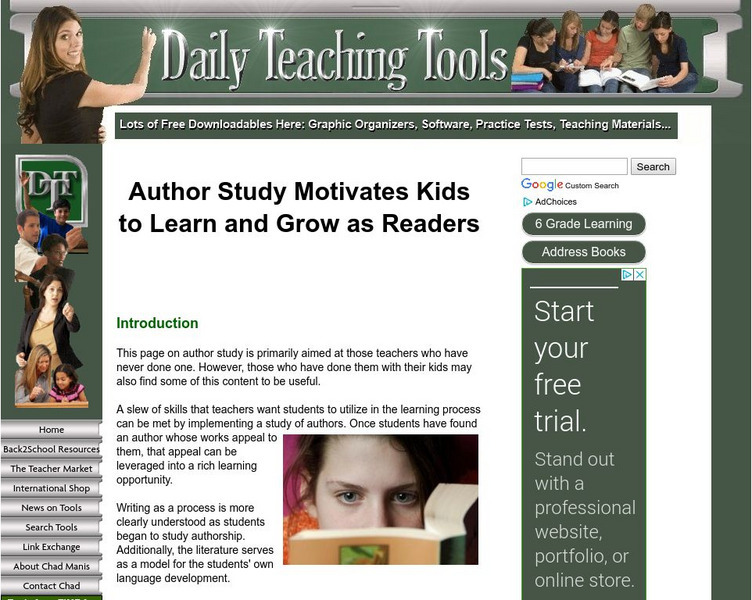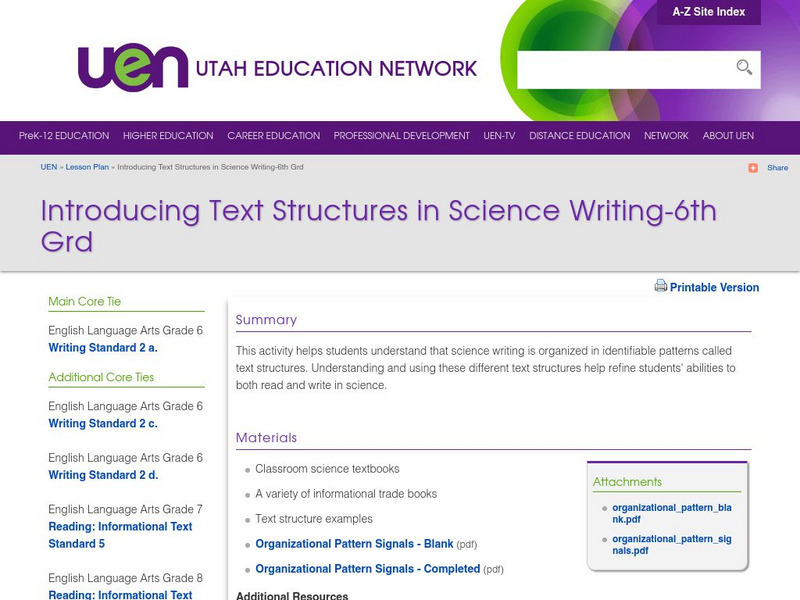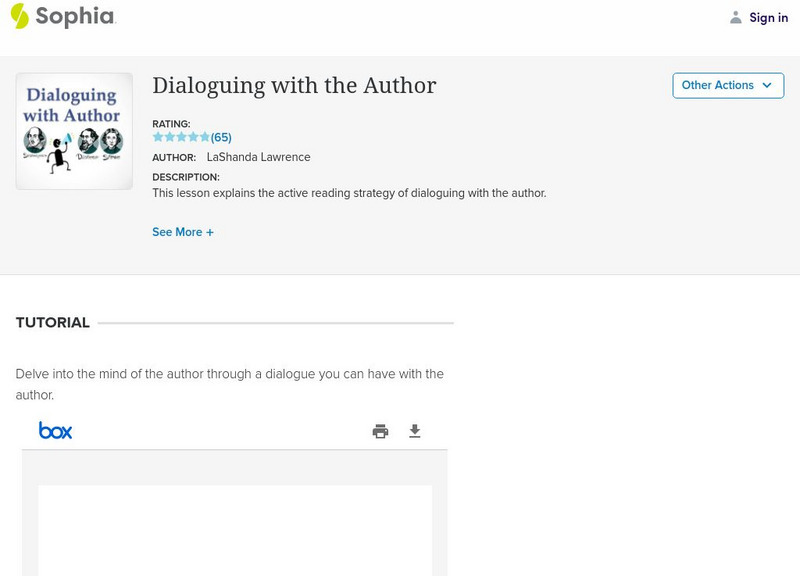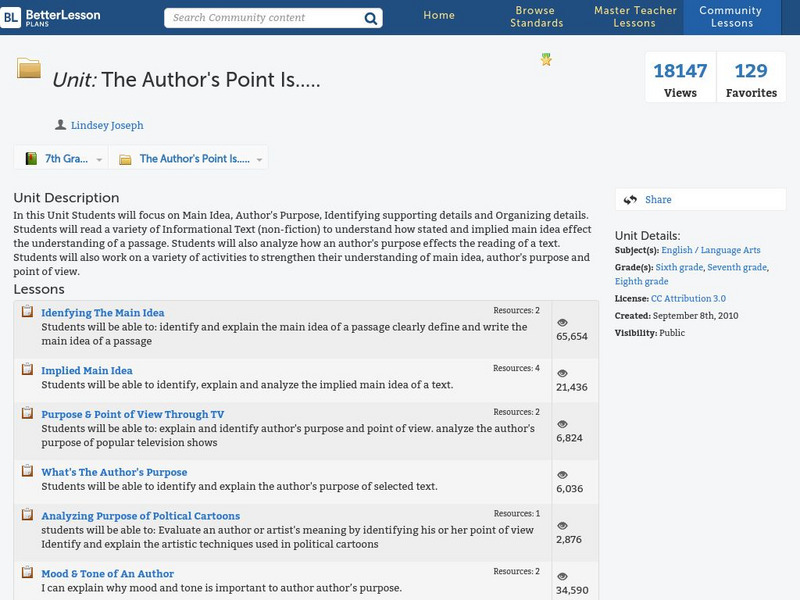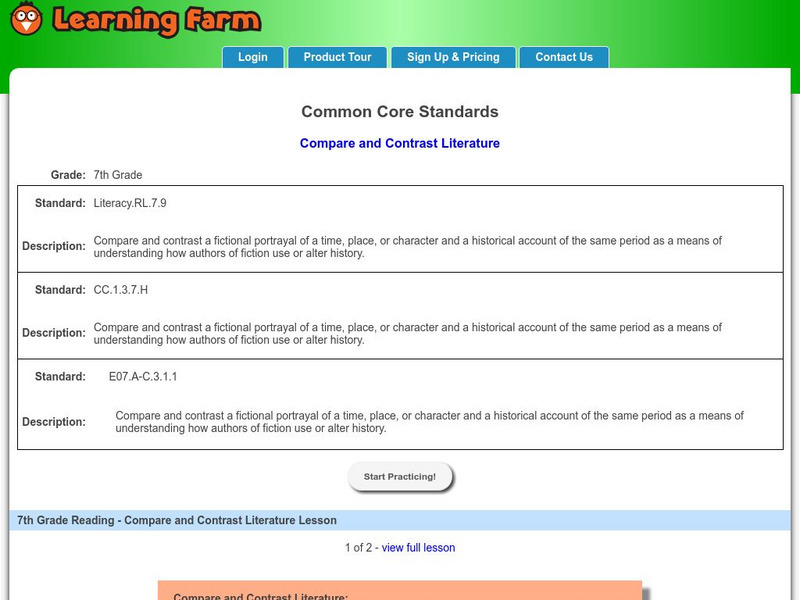Houghton Mifflin Harcourt
Holt, Rinehart and Winston: Elements of Literature: Narrator Chart [Pdf]
Provides an overview of the importance of a narrator in a text and some brief exercises for analysis. Helps students learn more about the role of the narrator in literature, his/her voice, and influence on other characters and events.
Other
Concepts and Practices for Writing Courses: Interpreting Literature
This tutorial surveys the way readers should interpret literature or text in symbols, syntax, meaning, and the like. The article features a Literary Toolkit for Analyzing Literature.
Daily Teaching Tools
Daily Teaching Tools: Author Study Letter Rubric
This Daily Teaching Tools resource provides a rubric. Each student will write a letter to an author of choice, and afterword, this rubric may be used to assess each letter.
E Reading Worksheets
E Reading Worksheets: Author's Purpose Scavenger Hunt
Identifying author's purpose scavenger hunts are included on this tutorial site. Students will scan their textbooks and find different purposes that are addressed in different sections of them.
E Reading Worksheets
E Reading Worksheets: Character Traits Project
In this learning module, students will learn more about learn more about character traits. Directions and rubrics for a group project are provided to reinforce the understanding of character traits. This module is designed to support...
E Reading Worksheets
E Reading Worksheets: Indirect Characterizations Worksheet
In this learning module, students will practice analyzing indirect characterizations. A worksheet is provided to reinforce the concept. This module is designed to support Tier I, Tier II, and Tier III students.
E Reading Worksheets
E Reading Worksheets: Tone Worksheets and Lessons
This learning module provides remediation and extra practice with identifying an author's tone. Reinforcement for understanding author's tone is provided through the five different worksheets and a mini-lesson. CCSS.ELA-Literacy.CCRA.R.4
E Reading Worksheets
E Reading Worksheets: Point of View Activities
This learning module provides assorted activities for teaching and reviewing the concept of point of view with students. The following activities are provided: point of view comic strip; point of view flash cards; point of view practice...
Other
Prezi: Inference Lesson 8th Grade
Learn what it means to make an inference by combining the author's clues and your background knowledge.
Utah Education Network
Uen: Lesson Plan: Text Structures in Science Writing
Lesson for teaching students to identify components of scientific texts and to use similar structures in their own scientific writing.
TES Global
Tes: Analyzing & Comparing Non Fiction
[Free Registration/Login Required] Resource notes to aid students as they analyze different types of nonfiction. The GAP (genre, audience, and purpose) acronym is provided to use when comparing nonfiction texts.
Read Works
Read Works: The Ex Factors
[Free Registration/Login Required] This informational text passage shares facts about the importance of physical activity on the body. This passage is a stand-alone curricular piece that reinforces essential reading skills and strategies...
Sophia Learning
Sophia: Referencing the Author's Purpose
This lesson explains how to reference an author's purpose when answering a reading comprehension question. This tutorial shares an audio version of the lesson's content. [3:14] RI.11-12.6 Eval Purpose, Rhetoric, Style
Colorado State University
Writing@csu Guide: Understanding Writing Situations
In this guide, you can learn more about the situations in which writers and readers find themselves and the physical, social, cultural, and historical contexts that shape them. Click on each of the links on the right to learn about the...
Sophia Learning
Sophia: Dialoguing With the Author: Tutorial
In this slideshow tutorial, students will review the reading strategy of questioning the author, also referred to as "dialoguing" with the author. The "dialoguing with author" strategy is explained, and examples of how to use the...
Annenberg Foundation
Annenberg Learner: Literature: Exploring Point of View
Use these brief explanations to help you determine the narrator and point of view in any piece of literature. W.11-12.3a Narratives
That Quiz
That Quiz: Author's Purpose
In this 10 question, self-grading quiz, students read a topic and label the author's purpose as to inform, entertain, or persuade. The quiz is timed, but not limited.
Better Lesson
Better Lesson: Unit: The Author's Point Is
Students will focus on Main Idea, Author's Purpose, Identifying supporting details and Organizing details. Students will read a variety of Informational Text (non-fiction) to understand how stated and implied main idea effect the...
E Reading Worksheets
E Reading Worksheets: Author's Purpose Lesson
In this learning module, students will learn about authors' purposes for writing. PowerPoint lessons, worksheets, and quizzes are provided to reinforce the understanding of why authors write assorted pieces. This module is designed to...
Tom Richey
Slide Share: Author's Purpose and Point of View
This downloadable slideshow focuses on how an author's purpose and point of view work together in fiction and nonfiction, and how to identify the point of view.
Texas Education Agency
Texas Gateway: Analyze Point of View in Literary Texts/fiction
Identify and understand an author's choice of point of view, including limited versus omniscient and subjective versus objective.
Quizlet
Quizlet: Ccisd 4th Grade Main Idea Match
Reading comprehension terms (nonfiction) are included in this review "Match" game. Questions are provided for the following words: main idea, summarizing, point of view, summarizing, topic, support, conclusion, details, author's purpose,...
Other
Sas: Exploring Ways Authors Use Text Structures to Convey Meaning
In this lesson plan, students will explore ways authors use text structures to convey meaning through cause and effect, sequencing, comparison, and more.
Learning Farm
Learning Farm: Compare and Contrast Literature
Students will learn how to compare and contrast passages from different time periods. Analyzing the similarities and differences of in the way authors show a historical time, place, or a character gives the reader a broader understanding...


![Holt, Rinehart and Winston: Elements of Literature: Narrator Chart [Pdf] Graphic Holt, Rinehart and Winston: Elements of Literature: Narrator Chart [Pdf] Graphic](http://content.lessonplanet.com/resources/thumbnails/410058/large/bwluav9tywdpy2symdiwmduymc03nzcylxblamtwbi5qcgc.jpg?1589985144)

